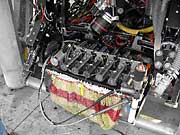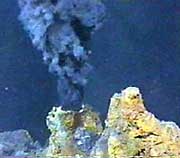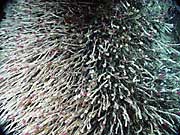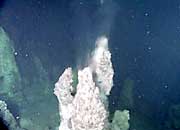
skip to content program navigation
| Learn more about these OCEAN and COASTAL RESEARCH areas... |
More OCEAN EXPLORATION and UNDERSEA RESEARCH topics:
Ocean Exploration and Undersea Research
Hydrothermal Vents
History
For over 20 years, the PMEL
Vents Program has investigated the effects on the oceans of deep-sea
volcanoes and hydrothermal systems. The approach of the Vents Program
has combined exploration, long-term time series observations, remote monitoring,
and innovative oceanographic instrumentation with an aim of providing
timely information to the scientific community and the general public
via peer-reviewed scientific publications and internet-accessible data
and educational products.
Over 70% of the earth's volcanic activity takes place beneath the sea surface, where it has an impact on deep ocean mixing, the global chemical and heat balance, and what may be the most ancient biological communities on the planet. PMEL/Vents is recognized for conducting unique research on submarine hydrothermal systems that address these key issues. By gaining access to data from the Navy's "SOSUS" acoustic monitoring system and developing additional hydrophone systems at PMEL, Vents has been locating earthquakes and using natural ambient ocean sound to study whales and alert scientists about ongoing volcanic eruptions on the seafloor. This acoustic monitoring led to the first remote detection and response to a seafloor volcanic eruption in 1993 on the Juan de Fuca Ridge in the NE Pacific. Since that time, PMEL has detected several more volcanic eruptions on the Juan de Fuca and joined academic researchers from the university community in rapid response efforts to identify the immediate effects of volcanic activity.
PMEL/Vents Program
The Vents Program has developed and deployed innovative instruments to
monitor and quantify volcanic and hydrothermal processes. A large effort
has been focused on the New
Millennium Observatory (NeMO) at Axial Volcano on the Juan de Fuca
Ridge, where a suite of instruments has been monitoring volcanic and hydrothermal
activity nearly continuously for over six years. One of the goals of NeMO
is to understand the extent of the sub-seafloor biosphere and to link
the geologic, chemical, and biological processes that have allowed life
to thrive in and around submarine volcanoes for billions of years. Recent
studies using a unique sampling tool (the Hydrothermal Fluid and Particle
Sampler) have shown how microbial communities respond to changing conditions
following a volcanic eruption. NeMO includes many temperature sensors
in hot springs, deep-ocean moorings with physical sensors, continuous
geodetic measurements, inter-annual sampling and survey missions, an exciting
education and outreach component, and a unique, real-time, two-way communication
system (NeMO-Net). NeMO-Net provided images of hydrothermal vents in the
first two years, and now has geodetic and chemical sampling capability.
A bottom pressure recorder monitors volcanic inflation/deflation associated
with magmatic activity, and the interactive sampler monitors vent temperature
and pH and collects samples on a weekly schedule or on command. Using
underwater acoustic and satellite data transmission, NeMO-Net is the first
deep-ocean observatory with the capability to respond from shore to a
volcanic or hydrothermal event. This pioneering technology to connect
deep-sea observatories in remote locations to shore-based laboratories
will be a major part of the global scale Ocean Observatories Initiative.
The Vents Program has become increasingly global in scope to reflect the nature of seafloor volcanism and to explore the full range of processes that occur in the wide range of volcanic environments beneath the sea surface. Autonomous acoustic monitoring now covers significant parts of the Pacific and Atlantic oceans. Vents Program scientists have led expeditions to explore venting on the remote, super-fast-spreading East Pacific Rise from 11 to 32°S, on the Explorer ridge in the NE Pacific, and on the Mariana volcanic arc in the western Pacific. With a coordinated team of geophysicists, geologists, oceanographers, chemists, and collaborating biologists and microbiologists, the Vents Program is poised to make new discoveries about the tectonic and volcanic processes that shape our planet.
Other Hydrothermal Vent Research Supported Within
NOAA
Although the majority of research conducted on hydrothermal vent systems
within NOAA occurs through the PMEL/Vents Program, NOAA also supports
a variety of research endeavors on hydrothermal vents through NOAA's
Ocean Explorer Program and the NOAA
Undersea Research Program. For example, NOAA's Office of Ocean
Exploration (OE) has supported several research cruises to explore
the Pacific Ring of Fire (which is part of the Mid-Ocean Ridge System)
for undocumented
hydrothermal vent activity. OE also worked collaboratively with
the Woods Hole Oceanographic Institution and a coordinated team of
scientists in 2002 for a return to the Galapagos
Rift to reexamine vents first discovered in 1977. NOAA's National
Undersea Research Program has also supported many endeavors to examine
specific aspects of hydrothermal vent systems in the Atlantic as
well as the Pacific Oceans.
Hydrothermal Fluid and Particle Sampler mounted on the ROV ROPOS. The sampler can collect particles on filters for chemical and microbiological analysis, collect water samples, including gas-tight samples in the titanium cylinders spread across the top of the sampler.
An image of a black smoker at the Juan de Fuca Ridge. The Vents Program conducts research on the impacts and consequences of submarine volcanoes and hydrothermal venting on the global ocean
These spectacular tubeworms discovered at Explorer Ridge cover Zooarium, a lower-temperature sulfide chimney, which was given its name because of all of the lush vent biota which inhabits it.
Shimmering water spews forth from the newly discovered "Cleopatra's Needle." Notice the majestic spires of surrounding vent chimneys in the background at the Mystic vent field within the Magic Mountain hydrothermal area. |
NOAA Research programs that study Hydrothermal Vents:
![]() Pacific
Marine Environmental Laboratory
Pacific
Marine Environmental Laboratory
![]() NOAA’s
Undersea Research Program
NOAA’s
Undersea Research Program
![]() NOAA’s
Ocean Explorer Program
NOAA’s
Ocean Explorer Program
Additional Related Information: PMEL
Vents Program |
|
More OCEAN EXPLORATION AND UNDERSEA RESEARCH topics:
|




